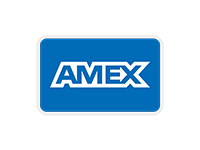By John Riddell
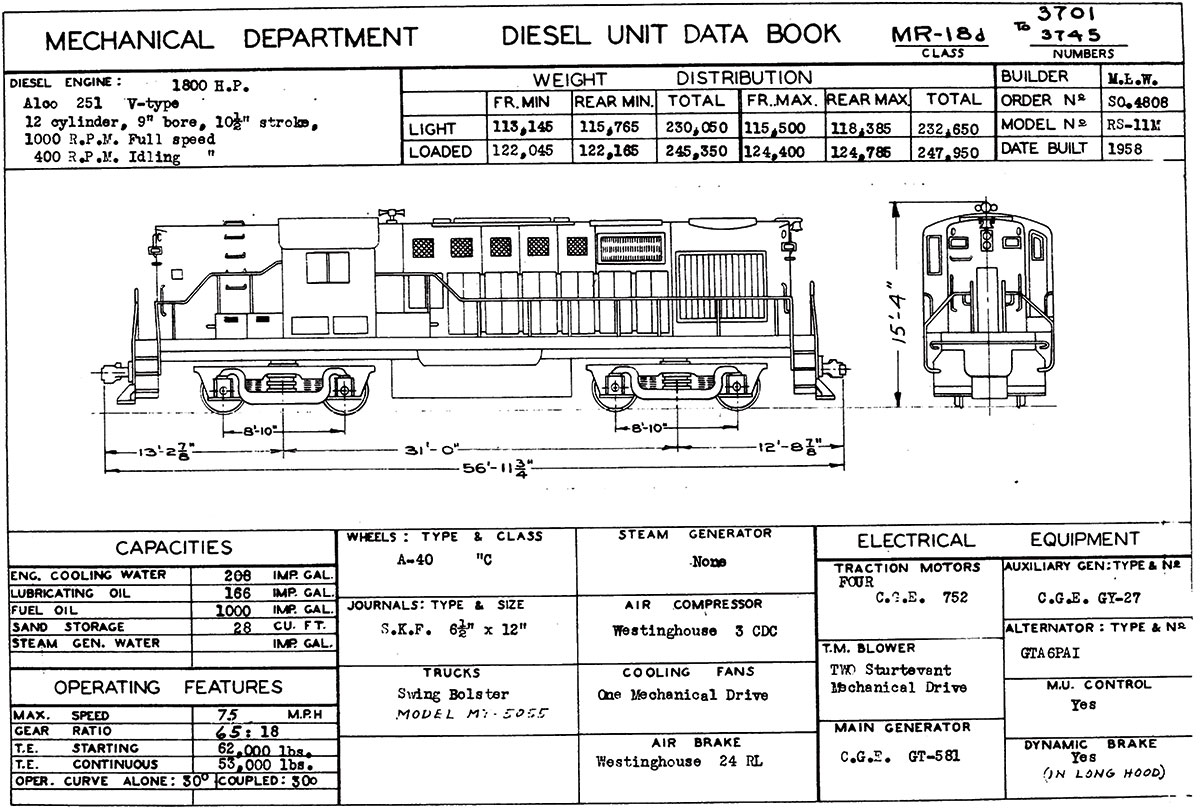
CN Mechanical Department drawing of a Class MR-18d RS-18.
The RS-18 was a highly successful general-purpose road-switcher, unique to Canadian railways. It was the successor to the RS-10 which had proved to be somewhat unreliable with its 1,600 h.p. 244 diesel engine.
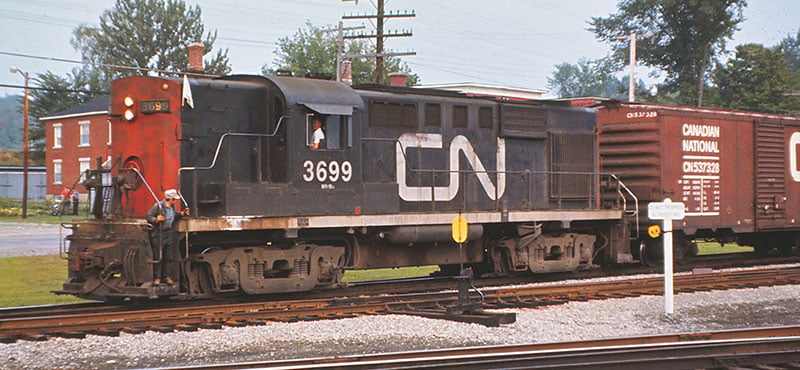
CN RS-18 3699, the last of the MR-18c class, works the yard at Richmond, Quebec in September 1971. Kaluza-Mueller collection.
The model RS-18 road-switcher locomotive, built by Montreal Locomotive Works (MLW), was the Canadian version of the Alco-built model RS-11 and was alike in most aspects externally and internally except for having a notchless feather-edge hood peak instead of the deeply notched Alco hood design. The locomotive dimensions were 56’11 ¼” length over couplers and 14’9 ½” height above top of rail.
The locomotive was powered by a 12 cylinder model 251B diesel engine rated at 1,800 h.p. coupled to a generator powering four GE traction motors. The locomotive rode on two B-B trucks. The RS-18 received much wider acceptance in Canada than its counterparts did in the United States. The RS-18 was considered to be MLWs most successful product from both an operational and a mechanical point of view. The MLW locomotive designation was DL-718.

When Canadian Pacific opted for larger power, many short line operators took advantage of the well built RS-18u's for their own needs. CP 8764, which was eventually rebuilt as RS-18u 1801, is today Ontario Southland 182. Don Jaworksi and Dan Dell'Unto photos.
The RS-18 model had good acceptance with MLW building 351 units over 12 years from December 1956 to June 1968 for eight railways in Canada. The original purchasers were Canadian National (225), Canadian Pacific (72), Pacific Great Eastern (29), Wabush Iron Company (11), Quebec Cartier Mining Company (8), International Nickel Company (3), Roberval & Saguenay (2), Quebec Iron & Titanium Corp. (1). After retired by their original owners, many RS-18s continued in service with secondary owners including Quebec-Gatineau Railway, New Brunswick East Coast Railway, Ontario Southland Railway, Delaware and Hudson Railway, Trillium Railway, Chemin De Fer Sartigan, Societe Du Chemin De Fer De La Gaspésie, Ottawa Central Railway, Cape Breton & Central Nova Scotia Railway. RS-18s gave many years of service with 116 still in service in 1994. Many were still in service in 2015. CN RS-18 no. 3684 is preserved in the Canadian Railway Museum in Saint-Constant, Quebec. The RS-10 preceded the RS-18. The RS-18 had a 1,800 h.p. 251B engine compared to the earlier RS-10 with its 1,600 h.p. 244 engine. The 244 series engine proved to be trouble prone. Most RS-10s on the CN roster were retired in 1967 and 1968, with CP hanging on to theirs until the mid-80s. While the RS-10 and RS-18 didn't share the same engine, they shared an almost identical body design. The only reliable spotting feature distinguishing an RS-10 from an RS-18 is the twin air filter. The RS-18 generally had five single air filters in this location, with variations of this from railway to railway
Variations
MLW offered customers a number of options for RS-18. The locomotive could be ordered to operate either short hood forward or long hood forward. The customer had a choice of standard or lightweight versions. The heavyweight units usually – but not always – rode on standard Type B trucks with a 9’-4” wheelbase, prominent leaf springs and outboard brake cylinders. The lightweight units rode on a shorter 8’-10” wheelbase without leaf spring secondary suspension. The locomotive could be ordered with a full height short hood or a low height short hood. A choice of four different fuel tanks was available: 1,000 Imperial gallon (1,200 U.S. gal.) tanks in two different styles: a tank mounted longitudinal parallel to the locomotive frame, a tank mounted transverse to the frame near the cab end of the locomotive, a 1,600 Imperial gallon (2,000 U.S. gal.) tank. a 2,200 Imperial gallon (2,600 U.S. gal.) tank. The units could be ordered with dynamic brakes, installed in either the short hood or in the long hood above the engine. When dynamic brakes were in the short hood, louvers were on the right side of the short hood. RS-18s could be ordered equipped with a steam generator however no such RS-18s were ordered. Some units were ordered with steam lines so that the units could be used in the consist of a steam-heated passenger train. Instead of loco- installed steam generators CN preferred to use separate steam generator cars for passenger trains. In addition there were numerous small external visual differences including side doors, side louvers and access covers on the roof. During the years of production MLW introduced various changes. In late 1959 MLW replaced the rectangular stamped metal Farr grill over the intercooler piping with a simple wire mesh screen. Car body air intakes originally had two square openings were later replaced by a rectangular three-panel cluster. Over the years many RS-18s were modified, including some which had their trucks changed.
Canadian National
CN was the biggest buyer of RS-18s with 225 serving more than 30 years. CN bought 131 standard and 94 light weight units. The units arrived from MLW in numerous groups from December 1956 to August 1960. The original road numbers were 3615-3893. The first two units, 3615 and 3616, were delivered on December 4, 1956, tested as demonstrators and later assigned to Moncton. CN assigned seven classes to its RS-18 locos: MR-18-a to MR-18-g, CN units carried 1,000 Imperial gallon fuel tanks of two styles. A longitudinal tank was parallel to the locomotive frame. On lightweight units a transverse tank was mounted near the cab end of the locomotive only half filled the gap between the trucks. The air reservoirs were mounted crosswise in the vacant space. All CN units were delivered configured to run with the long hood forward. CN units were delivered with three different carbody filter arrangements. CN ordered 30 units with 80-mph gearing and steam lines for passenger service. In 1967 CN rebuilt six RS-18s with a new engine and extended length short hood for Tempo passenger service in southwestern Ontario.
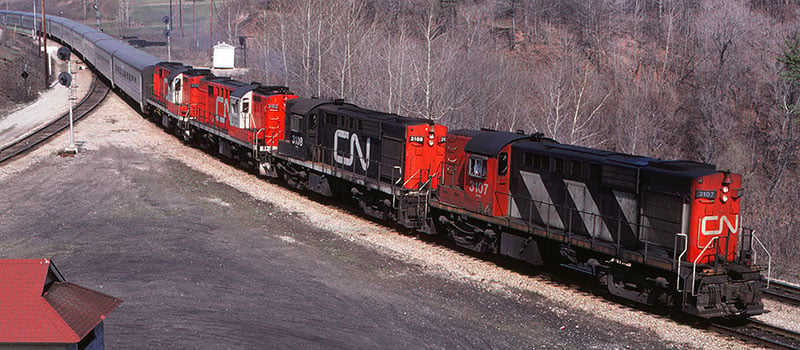
As if photographed just for this Master Class, CN class MR-18e 3107 and 3108 lead Tempo-rebuilt Class MRE-18g 3152 and 3155 with VIA Train no. 72 at Bayview Junction on April 25th, 1980. Kaluza-Mueller collection
The RS-18 was the second-most-numerous road-switcher model of CNs first-generation diesel roster. Most spent their lives in Ontario, Quebec and the Maritimes. In 1975 and 1976 CN Moncton shops retrucked 38 RS-18’s with A-1-A trucks from retired RSC-13’s so that they could be used on light rail branch lines in Nova Scotia, New Brunswick and Prince Edward Island. They were classed RSC-14 (owing to the fact they were de-rated to 1400 hp) and assigned to Charlottetown, Moncton and Halifax. A traffic slump in the spring of 1989 left fewer than 15 units in service. These were restricted to yard or transfer work following CNs decision to not equip any RS-18s with new safety features required on mainline locomotives in Canada. CN retired its last RS-18 in September 1993.
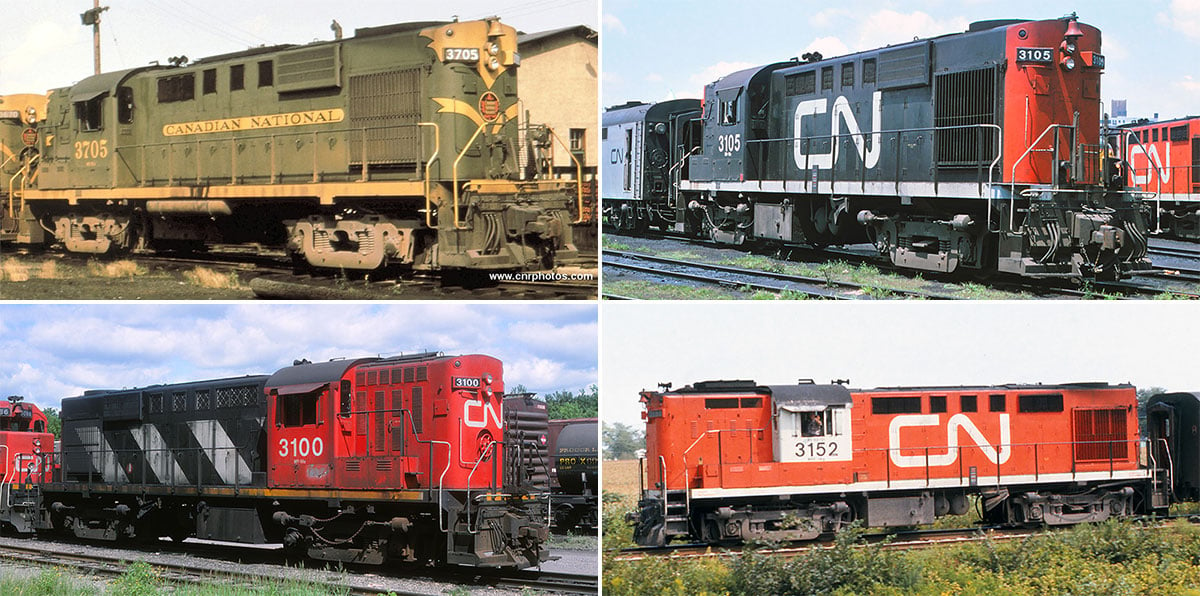
he four schemes worn by CN RS-18s over the course of their tenure (clockwise from top left): Green & Gold (Delivery), Noodle, Tempo and Stripes. CNRphotos.com and Kaluza-Mueller Collection.
Paint schemes
All CN units were delivered in the green scheme: green body, mustard yellow name panel on the sides and yellow nose with brow ribbons adorning both ends with a black pin stripe separating the green from the yellow. The lettering was Extended Railroad Roman. On each end was a circular herald with Canadian National Railways in yellow on a red maple leaf. Starting approximately 1961 the units were gradually repainted in black body, orange-red ends and a light gray 12’-11” long CN symbol, road numbers and running board trim line. Later the units were gradually repainted with red cab, short hood, end of long hood and black and light gray 45-degree diagonal stripes of the sides of the long hood and a yellow running board trim line.
Canadian Pacific
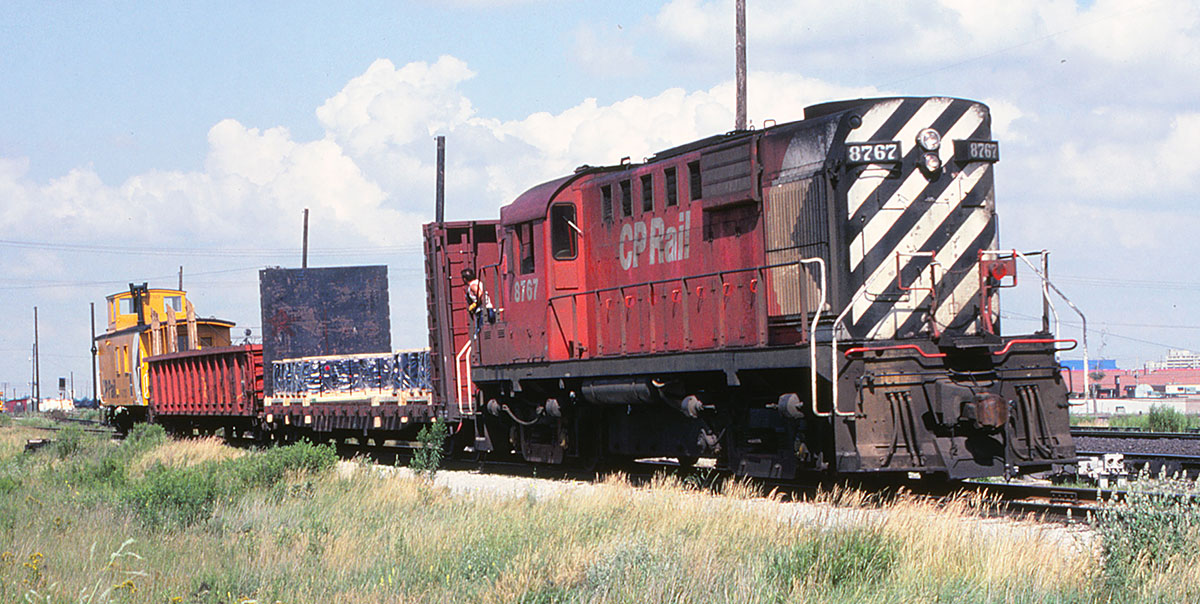
CP Rail RS-18 8767 is seen working a local in Agincourt (Toronto), Ontario in late July 1980. John Sjolander photo, Kaluza-Mueller collection.
Canadian Pacific was the second biggest buyer of RS-18s with 72 serving more than 30 years. The units arrived from MLW in numerous groups from March 1957 to July 1958. CPR assigned classes DRS-18a and DRS-18b and road numbers 8729-8800. CPR units were equipped with a 1,200 Imperial gallon fuel tank mounted parallel to the frame. Unlike the CN units, all CPR units were delivered configured to run short hood forward. All units were equipped with a steam trainline so that they could be used as a trailing unit behind a steam generator equipped unit. Ten of the new RS-18s were originally assigned to the Prairie Region between Winnipeg and Fort William in through and fast freight service. They were maintained at Chapleau. The remaining 10 units were assigned to St. Luc for through freight service on the Eastern Region. Most CPR units spent their lives in Ontario, Quebec and the Maritimes sometimes straying west of Winnipeg. In 1994 all 61 remaining CP Rail units were assigned to St. Luc Yard (Montreal) for maintenance purposes. As numbers of new SD40/-2’s arrived, the older RS-18s were filtered down to secondary trains and branch lines until completely supplanted by second generation locomotives.
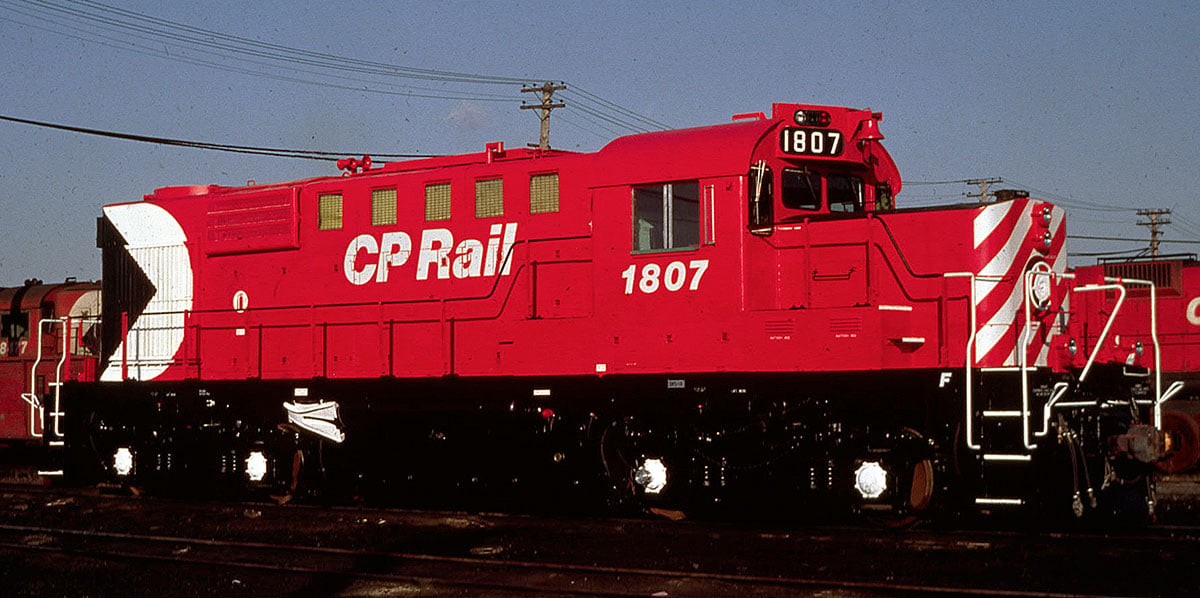
Under a stormy sky, CP RS-18u 1807 is seen fresh from the paint shop after rebuild in 1981. Brian Schuff photo.
Rebuilding Program
The RS-18 as a fairly reliable first-generation model was chosen to fulfill an important role in road-switcher service in the 1980’s. Starting in 1980, twenty two CPR RS-18s were extensively rebuilt in Angus Shops, Montreal to extend their useful lifespan another 10-15 years. CPR eventually rebuilt all 69 of its remaining RS-18s. In the rebuilding the units were substantially transformed in both appearance and performance.
They emerged with numerous changes including chopped short hoods to improve visibility, overhauled engines and trucks, modified uncoupling levers, improved heating systems, new wiring, windows, cab insulation and control stands. They were assigned a model RS-18u and new road numbers 1800-1868. The dynamic brake and 251 engine rated at 1,800 h.p. remained the same after the overhaul.
Five of the RS-18u’s, 1800-1804, had U.S. duty paid on them, allowing them to run on U.S. branch lines with no restrictions. Other units were limited as to how long they may spend in the U.S. After purchasing the Delaware & Hudson, CPR assigned several RS-18us to the D&H for use in yard and local service. CP Rail assigned rebuilt units from the 1800-1804 group to Newport, Vermont to work the Newport to St. Johnsbury wayfreight.
To find out more on the rebuilding program, please click here to read the excellent CP Tracks article written by Ken Goslett and Kevin J. Holland and published in their issue 12-4.
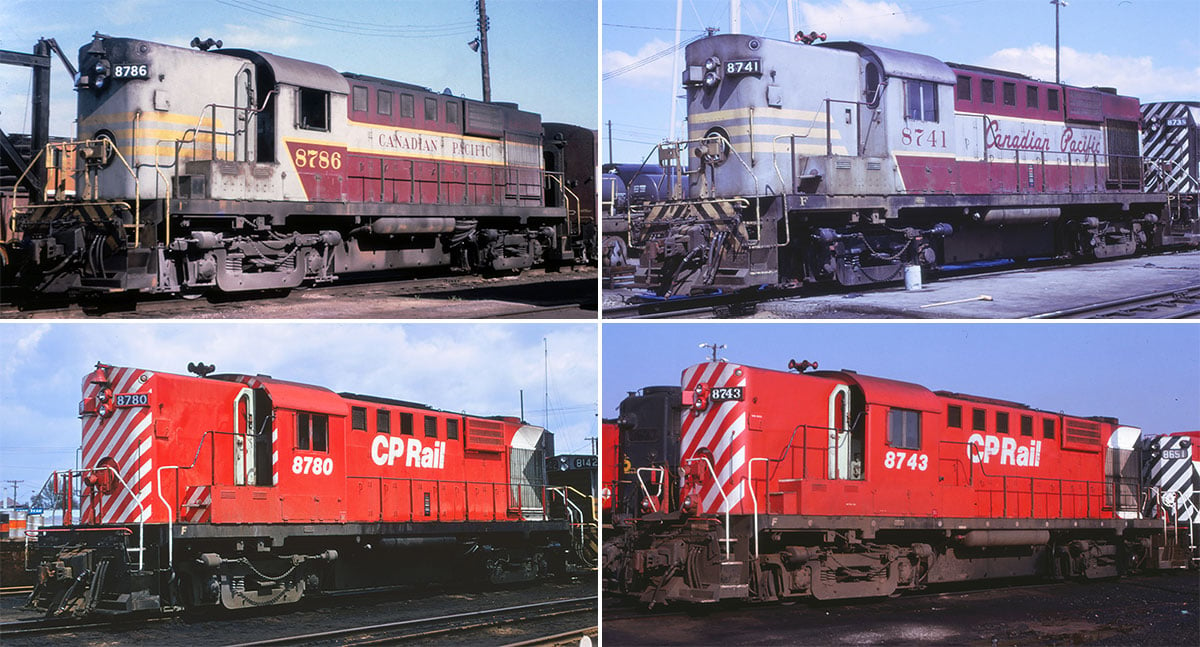
The four primary schemes worn by CPR RS-18s over the years included (clockwise from top left): Block (Delivery), Script, Action Red w/ 5" stripes, and Action Red w/ 8" stripes. All photos courtesy Don Jaworski.
Paint schemes
All CPR units were delivered in the Tuscan red and gray scheme with three horizontal 6” wide yellow stripes on the front of the short hood. The name was in Tuscan red 12” block lettering on the 18” wide gray side stripe. Locos were repainted in this scheme until August 6, 1965. From August 6, 1965 until October 11, 1968 locos were gradually repainted with a wider 34” gray side- stripe with Canadian Pacific in Tuscan script. After October 11, 1968 locos were gradually repainted in Action Red scheme with white CP Rail. 8” striped ends, 5” wide frame strips and black and white multimark on both sides of long end. The Action Red scheme evolved with numerous revisions.
Pacific Great Eastern/BC Rail
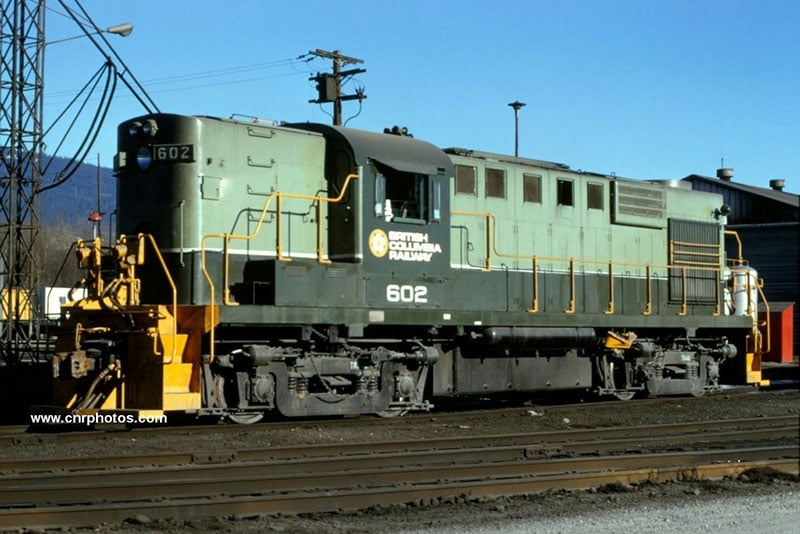
British Columbia Ry RS-18 602 (ex PGE 602, exx PGE 588) sits at North Vancouver, BC on January 5th, 1974. Built in 1957, it would receive a chop-nose by 1984 and a rebuilt CAT engine in the early 90s before finally being retired in 2004. CNRphotos.com collection.
The third largest buyer was PGE which purchased 29 RS-18s. They were built from 1957 to 1966 and numbered 601 to 630. Four units, nos. 601-604, had a high short hood. Twenty-five units, nos. 605-630, had a low short hood. These replaced the RS-3’s and RS-10’s in road service but in the 1970s were in turn replaced by C-630Ms and M-630s. The PGE name was changed to British Columbia Railway on April 1, 1972 and later to BC Rail on June 19, 1984. The PGE RS-18’s received a number of colourful paint schemes over their lives.
- Orange overall body with 12” green stripe around the body. A circular caribou herald on the cab side with caribou facing forward.
- Dark green overall body with road name in 10” orange letters on the sides. A circular caribou herald on the cab side with caribou facing forward.
- Same as above with orange ends.
- Same as above with PGE in 24” tall orange letters on the cab sides.
- Same as above with PGE map herald in orange on the cab sides.
- Top half of body light green and bottom half dark green. With PGE map herald on the cab sides.
- Same as above with cab all dark green and British Columbia Railway herald on the cab sides.
Wabush Iron Company
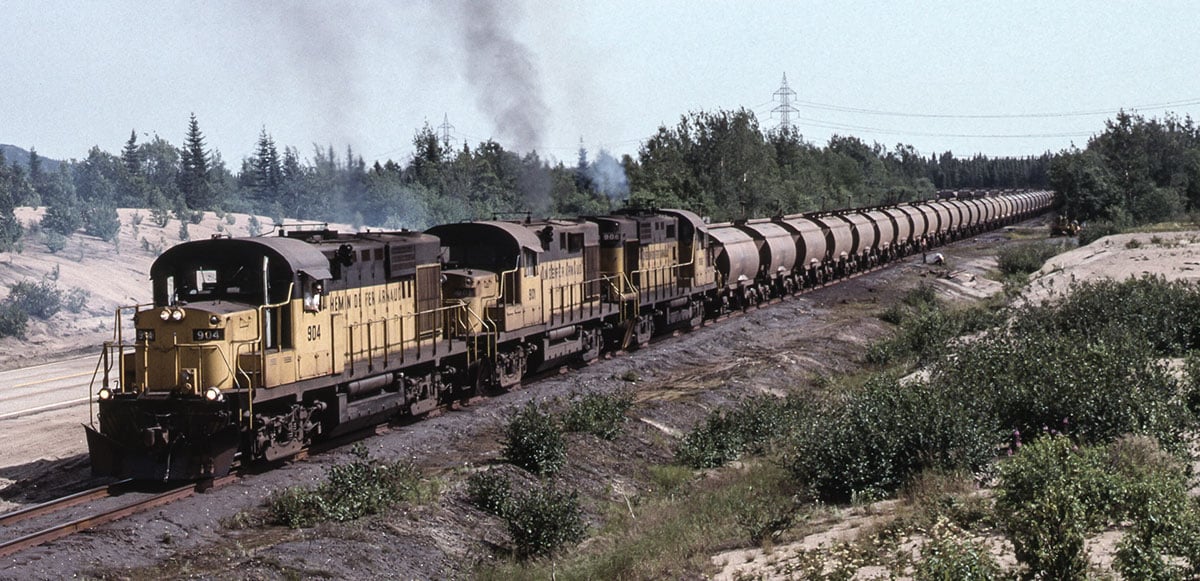
Arnaud Railway RS-18s 904, 901 and 906 smoke it up at Pointe Noire, Quebec in 2001. Ken Goslett photo.
Wabush Mines owned the Wabush Lake Railway and the Arnaud Railway in northern Quebec. Wabush purchased seven RS-18s for the Arnaud Railway and four for the Wabush Lake Railway from 1960 to 1964. Numbered 901 to 911 they had low short hoods. The paint scheme had the top half of the body black and lower half yellow with black and yellow diagonal stripes on each end pilot. The road name was printed in black on the yellow long hood.
Quebec Cartier Mining Company
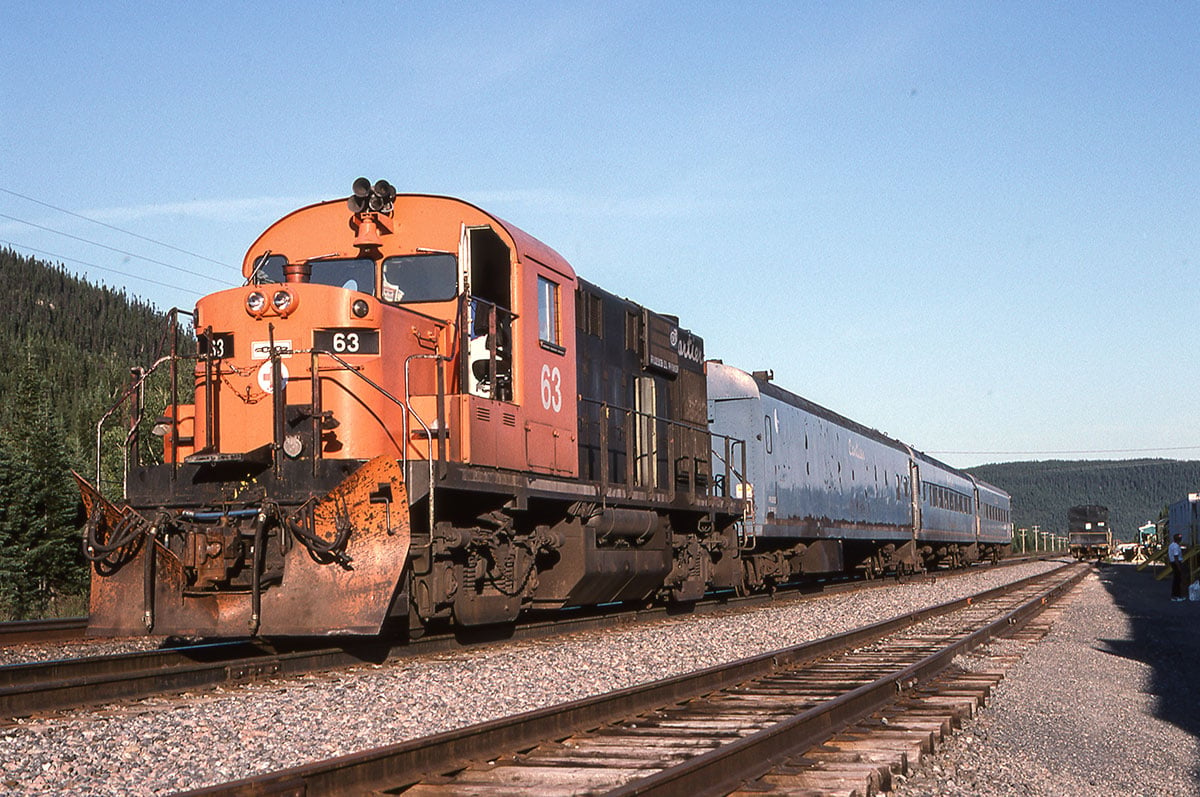
Quebec Cartier RS-18 no. 63 is shown discharging passengers at Charles in 2001. Ken Goslett photo.
The QCM Company purchased eight RS-18s for its railway in northern Quebec. Built in 1959 and 1960, they were numbered 101-108 and had low short hoods. The units carried four paint schemes over the course of their careers with QCM. The first was a gray body with wide blue stripe bordered by yellow stripes with logo on lower cab sides. The second scheme featured a blue body with yellow end stripes and frame edge with logo on lower cab sides. The third scheme had a green body, yellow short hood and green and yellow end stripes with word Cartier in yellow script on sides of long hood. The fourth and final scheme had an all-black body with an orange cab and short hood, white cab-side numerals and white stylized Cartier lettering along the top of the long hood. These units were later renumbered from 101-108 to 61-67. Apart from unit 61 which was scrapped following a wreck in 1972, units 62 and 64-68 were sold in 2002 to various parties. The remaining two units, 63 and 67, were sold for scrap in 2011.
International Nickel Company
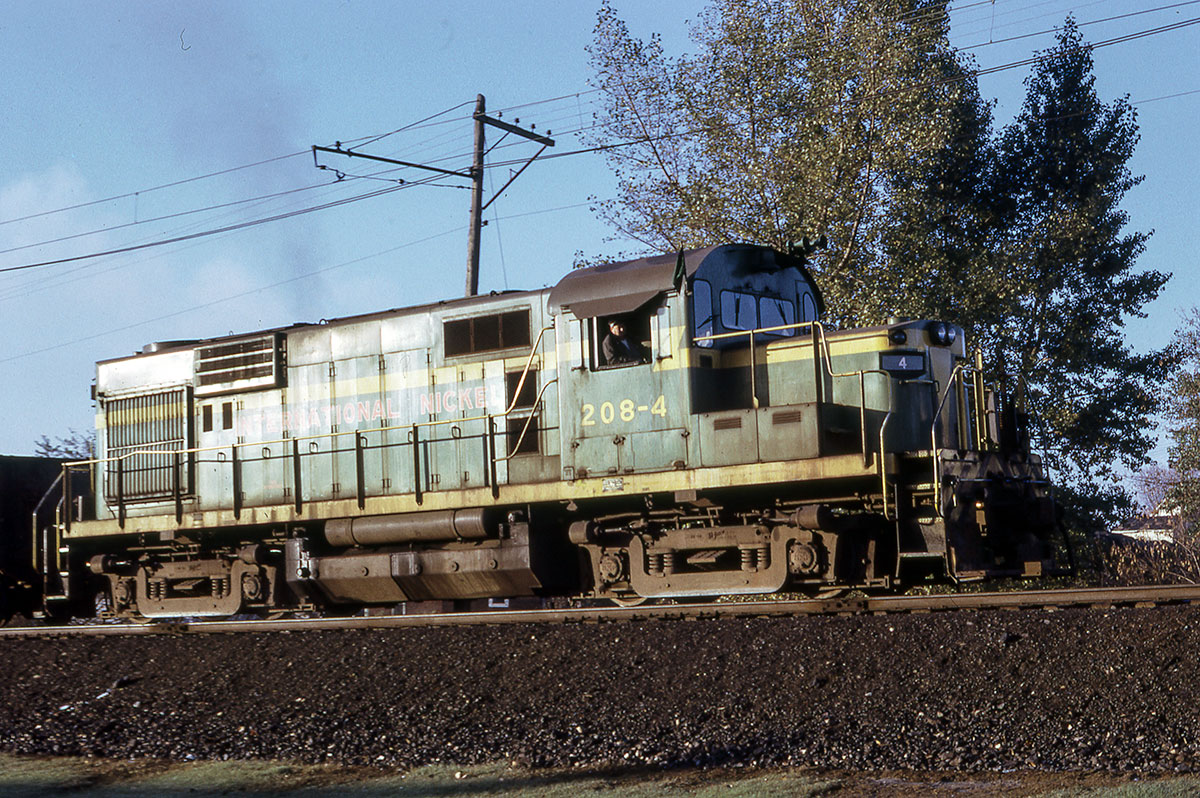
INCO RS-18 208-4 is shown at Copper Cliff, Ontario in 1970, showing the as-delivered paint scheme. Ken Goslett photo.
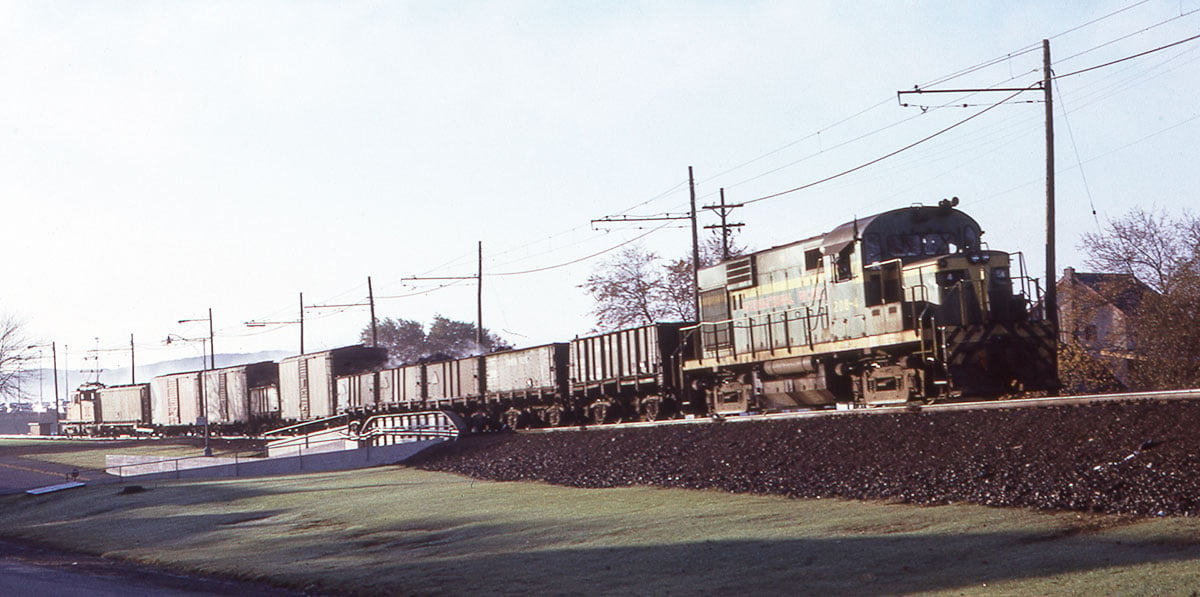
A wider shot of INCO RS-18 208-4 showing it's short 10-car train with a centre-cab electric giving a shove on the tail end. Ken Goslett photo.
INCO purchased three RS-18s in 1968 with low short hoods, numbered 208-2 to 208-4. As delivered they wore an all-green scheme with a yellow frame stripe, a second yellow stripe along the top of the short hood and higher on the long hood, yellow cab numbers and red International Nickel lettering along the long hood. Later they would be repainted into an all-yellow scheme with black numbers above the rear grills and a black "INCO" logo on the cab side. In 1995, 208-3 and 208-4 would be sold to Ontario Southland Railway as their 183 and 184 respectively. 208-2 was sold to the Ohio Central as their 1800.
Roberval & Saguenay:
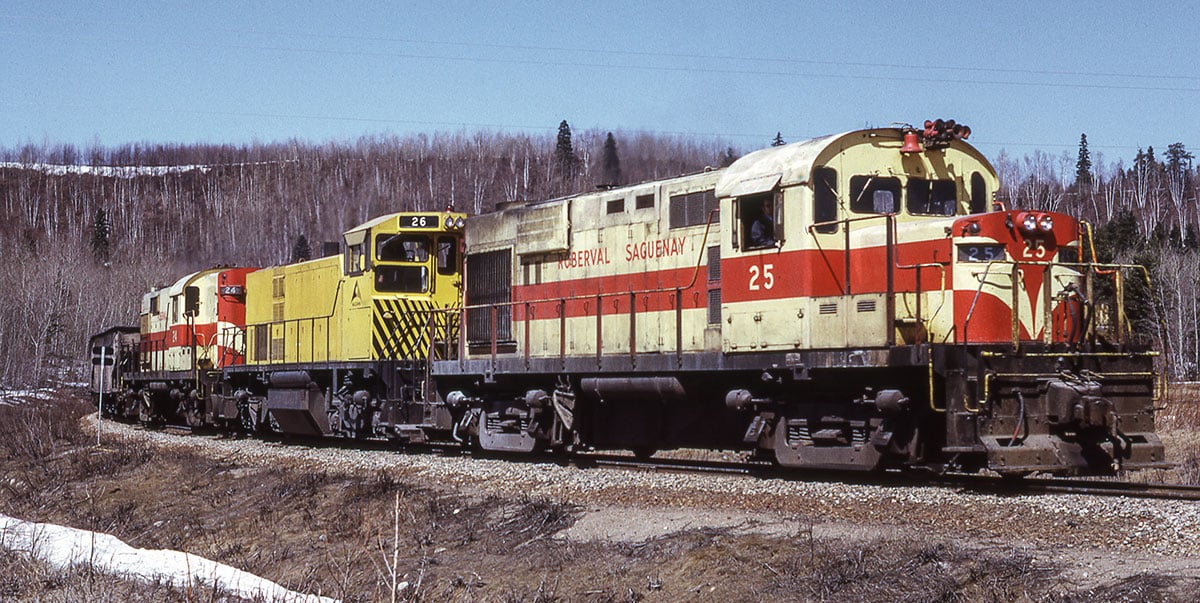
Roberval & Saguenay M-420TR 26 is flanked by RS-18s 24 and 25 as it descends the horseshoe curve heading into Port Alfred in 1973. Ken Goslett photo.
R&S purchased two RS-18s: Number 24 in 1960 and number 25 in 1965. While 24 had a standard high hood, 25 came delivered with a low hood, as was common with many later models. Both were delivered in a red and cream paint scheme with a cream base and a red stripe on the long hood, inverted to a red base with a cream V-shaped stripe .on the ends. Later they would be repainted in the stylized RS scheme with green letters on the long hood, with a yellow and light grey body. Both units were sold for scrap in 2000.
Quebec Iron & Titanium Company:
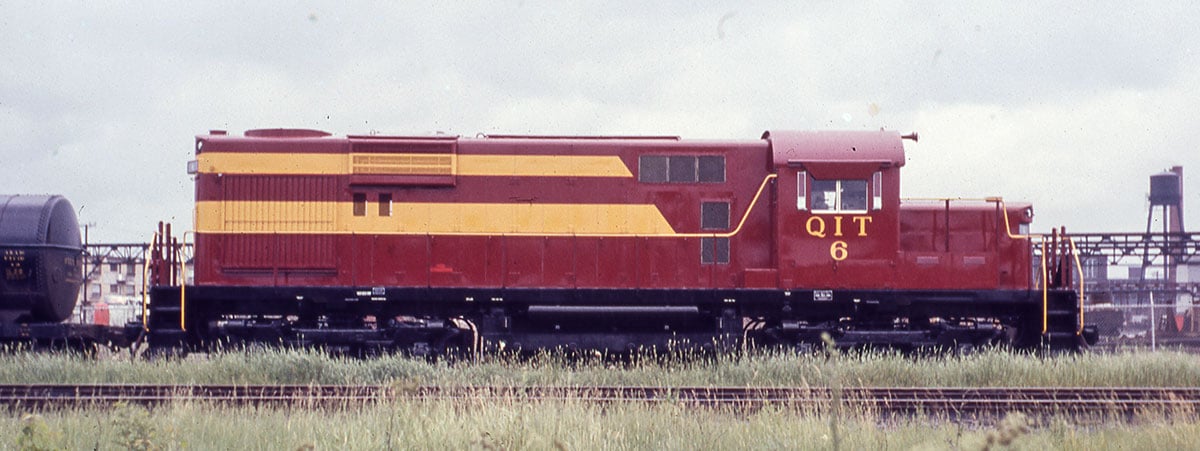
QIT RS-18 no. 6 is shown at the MLW plant gate on delivery day in June 1968. QIT 6 was the 2nd last RS-18 ever built. Ken Goslett photo.
QIT purchased one RS-18 in June 1968 as number 6 (later 16, then 46). It has a low short hood like many of the later RS-18 units purchased new from MLW. It originally wore an all-maroon paint scheme with twin yellow bands along the upper long hood. Later in life, it was repainted to have an orange band with white edge stripes along both the short and long hoods, which it maintains to this day.
Further Reference:
Courtney, Glenn, Ken Goslett and Kevin Holland. Canadian National Railways Diesel Locomotives Volume Two, 2014.
Kirkland, John. The Diesel Builders Volume Two, 1989.
Dean, Murray and David Hanna. Canadian Pacific Diesel Locomotives, 1981.
Zuters, Gary. CP Rail 1993 Review, 1994.
Extra 2200 South, Issue 48, (1974), issue 50 (1975), issue 82 (1985).
Pinkepank, Jerry. The Second Diesels Spotter’s Guide, 1973.
Lewis, Don. Rail Canada Volume 1, Diesel Paint Schemes of the CN System, 1976.
Lewis, Don. Rail Canada Volume 2, Paint Schemes of Diesels seen in Canada, 1977.
Lewis, Don. Rail Canada Volume 3, Diesel Paint Schemes of the CPR, 1979.
Lewis, Don. Rail Canada Mini 2-1 PGE / BC Rail Diesels 1948 to 1981, 2001.
Kerr, O.M. Illustrated History of MLW to Bombardier Diesel-Electric Locomotives 1979.
Kerr, J.W. Illustrated CN and CP Rail Motive-Power 1980-1981 1980.


